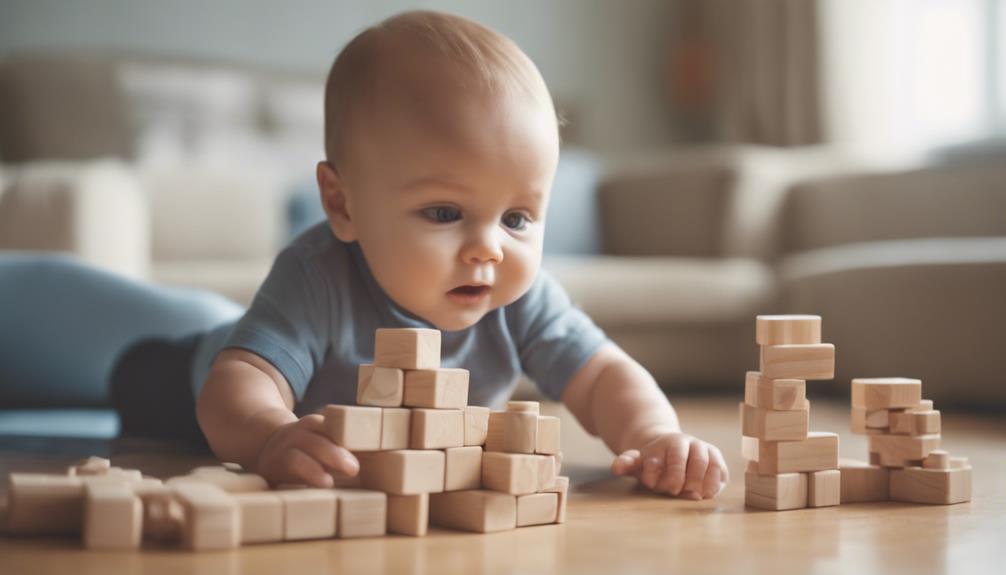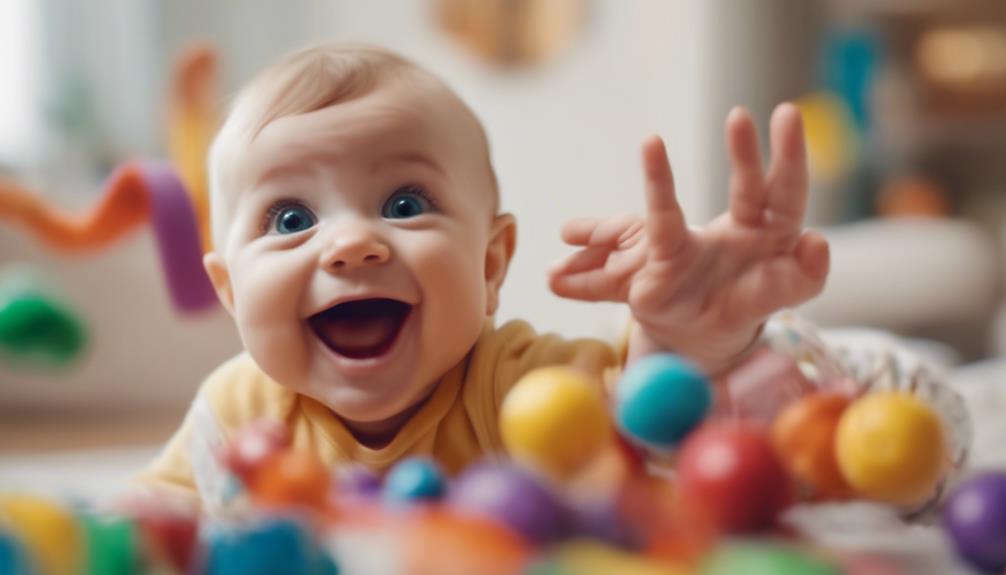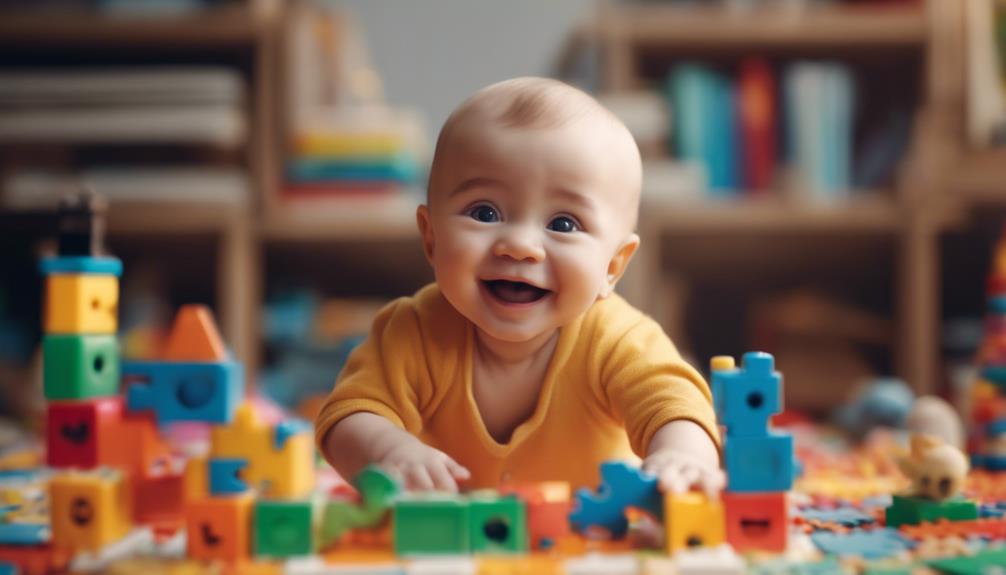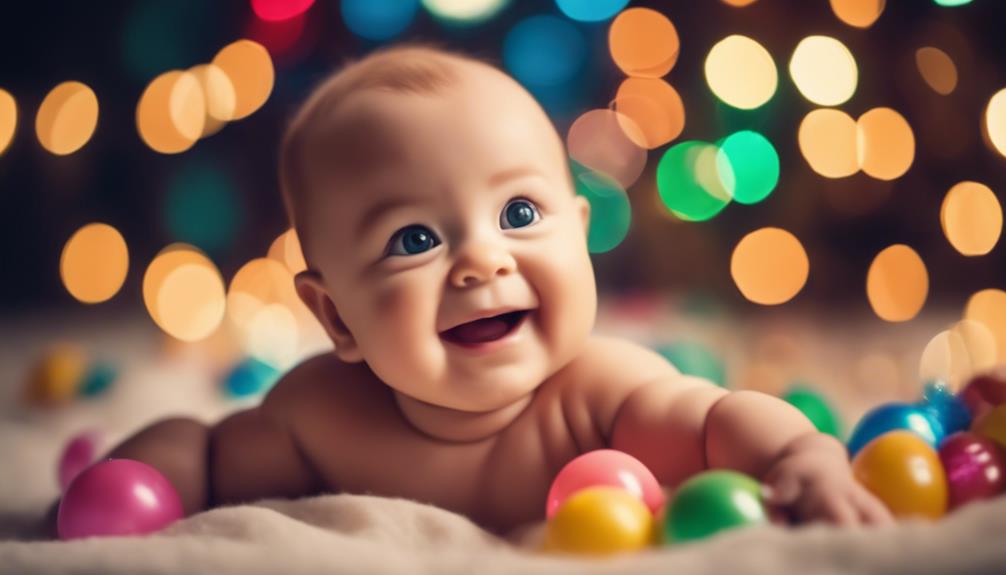To identify a joyful infant, observe for signals such as eye contact for connection, turning towards you to display recognition, and open mouth smiles indicating genuine happiness. A baby’s comfort in your embrace signifies feeling secure and loved, while cooing and babbling demonstrate developing communication abilities. Laughter, typically emerging between 3-5 months, indicates joy and well-being. These clues signify emotional attachment and satisfaction, nurturing your connection with your child. Recognizing these hints can offer reassurance of your baby’s happiness and emotional well-being. Interpreting these cues can strengthen your bond and enrich your parenting experience.
Key Takeaways
- Eye contact fosters connection and security.
- Turning towards familiar voices shows recognition.
- Open mouth smiles indicate genuine happiness.
- Melting in your arms signifies comfort and trust.
- Cooing and babbling enhance communication skills.
Eye Contact
Engaging in eye contact with your baby from an early age is essential for fostering a strong sense of connection and security. This simple act of meeting your baby's gaze can have profound effects on their emotional development.
Babies as young as a few weeks old are capable of engaging in eye contact as a form of communication. Studies have shown that eye contact is a precursor to social interactions and emotional bonding in infancy. It's through these shared gazes that the foundation for trust and attachment is laid.
When you lock eyes with your baby, you may notice the emergence of a social smile, indicating their joy and connection with you. This social smile is a significant milestone in their development, showcasing their ability to engage with others emotionally.
Consistent eye contact with caregivers not only enhances cognitive and emotional development but also fosters a sense of safety and security in babies. So, remember, those moments of eye contact aren't just fleeting glances but powerful tools in building a strong bond with your little one.
Turning Towards You

When a baby turns towards you, it signifies a strong emotional connection and sense of security. This simple act speaks volumes about the bond between you and the baby.
Here are some key points to take into account:
- Recognition and Connection: Babies show happiness by turning their heads towards familiar voices, indicating recognition and connection.
- Emotional Bond and Attachment: When a baby turns towards you, it demonstrates their emotional bond and attachment to you as their caregiver.
- Trust and Comfort: Turning towards you is a sign of trust and comfort, showing that the baby feels safe and secure in your presence.
- Preference for Interaction: This action signifies the baby's preference for your company and their desire for interaction and engagement.
- Strengthening Relationships: Recognizing when a baby turns towards you helps strengthen the parent-child relationship and fosters a sense of security and love.
Understanding the significance of a baby turning towards you can deepen the bond and create a nurturing environment for the little one to thrive.
Open Mouth Smiles

Around 6-8 weeks of age, babies typically start displaying open mouth smiles, revealing their genuine happiness through the showing of gums. These smiles are a clear sign of a happy baby, as they indicate the baby's positive emotional state and social engagement. Unlike reflex smiles seen in newborns, open mouth smiles are linked to emotions and are often elicited by caregiver interactions or playful activities. Research supports that open mouth smiles are a key indicator of a baby's well-being and contentment at this stage. Below is a table highlighting some key features of open mouth smiles in babies:
| Features | Details |
|---|---|
| Age Range | Around 6-8 weeks old |
| Expression | Reveals genuine happiness |
| Involves | Showing gums through an open mouth |
| Stimuli | Response to caregiver interactions |
| Emotional Indicator | Reflects positive emotional state |
Observing open mouth smiles in your little one can be a heartwarming experience, reassuring you of their happiness and emotional well-being.
Melting in Your Arms

As you hold your baby and feel them melt in your arms, you're witnessing a profound display of comfort and security. This physical response is one of the first two signs indicating a happy baby. It reflects a deep sense of trust and attachment, strengthening the bond between you and the little one.
Here are some key points to take into account:
- When a baby relaxes and melts in your arms, it shows they feel safe, loved, and content in your embrace.
- This behavior signifies a strong connection, fostering a sense of security and warmth for the baby.
- Enjoying being held and comforted in your arms is a positive indicator of the baby's happiness and emotional fulfillment.
- Babies melting in your arms is a sign of trust and attachment, promoting emotional well-being.
- It's a clear demonstration of the baby's comfort and happiness in your presence, reinforcing the sense of security in your relationship.
Cooing and Babbling

When babies start cooing around 2 months and babbling around 6 months, they're laying the foundation for their vocal development and communication skills.
These early forms of communication are essential for expressing joy and establishing connections with caregivers.
Encouraging and responding to your baby's cooing and babbling can enhance their emotional engagement and overall happiness.
Vocal Development
Encouraging your baby's vocal development through interactions and responses is essential for their early language skills. Around two months of age, babies start cooing, emitting soft, vowel-like sounds to express pleasure.
As they progress, typically between 4-6 months, babbling emerges, showcasing repetitive consonant-vowel combinations as they explore language. Cooing and babbling serve as foundational steps for future speech, playing an important role in language acquisition.
These milestones signal your baby's increasing ability to communicate and engage with others, fostering essential social connections. To support vocal development, parents can respond to their baby's sounds, engage in conversational exchanges, and nurture language skills from the early stages.
- Cooing begins around two months, reflecting your baby's joy and contentment.
- Babbling emerges between 4-6 months, indicating language exploration and development.
- Vocal milestones lay the groundwork for future speech and language acquisition.
- Cooing and babbling demonstrate your baby's growing ability to communicate and connect with others.
- Parents can enhance vocal development by actively engaging with and responding to their baby's vocalizations.
Communication Skills
Developing communication skills in babies involves recognizing the significance of their cooing and babbling as foundational steps towards language acquisition. Around 2-4 months of age, babies begin to express themselves through these vocalizations.
According to child development experts, cooing is an early form of communication that primarily consists of vowel sounds, while babbling introduces consonant-vowel combinations, laying the groundwork for future speech. These sounds aren't merely random; they serve as essential building blocks for language development.
By responding to your baby's coos and babbling, you aren't only acknowledging their attempts to communicate but also fostering a stronger bond with them. As pediatrician Dr. Smith explains, 'Encouraging these early communication skills is vital for your baby's overall development.'
Embracing and engaging with your baby's cooing and babbling sets the stage for improved language acquisition and enhanced social interactions in the future.
Lighting Up in Your Presence

If a happy baby is truly content, they'll light up in your presence, radiating excitement and joy. Their eyes will sparkle, and you may be greeted with a big, genuine smile.
When interacting with you, happy babies may coo, giggle, or babble happily, expressing their delight in your company. They might enthusiastically reach out for cuddles, hugs, or to be picked up, showing their desire for your attention and affection.
Your presence and interaction play a significant role in eliciting positive responses and engagement from a happy baby. Remember, babies are highly responsive to the stimuli around them, and your involvement can bring about a range of joyful reactions, indicating their happiness and contentment.
Laughter

Laughter in babies typically emerges between 3 to 5 months of age, signaling their joy and positive emotions. It's an important milestone in their development, indicating happiness and engagement.
Infants' laughter is a clear sign of their emotional well-being and serves as a means of communication with caregivers. Positive interactions and stimuli often evoke laughter in babies, creating a bond between the infant and their environment.
According to pediatrician Dr. Smith, 'Laughter in infants is an essential indicator of their overall happiness and contentment.' Recognizing and encouraging laughter can further foster emotional well-being in infants, promoting a positive and nurturing environment.
As noted by child psychologist Dr. Johnson, 'Laughter plays an essential role in infants' social and emotional development.' Parents and caregivers should cherish and encourage moments of laughter in infants, as it not only signifies joy but also strengthens the emotional connection between the infant and their caregivers.
Frequently Asked Questions
How Can You Tell if a Baby Is Happy?
To tell if a baby is happy, notice their smiles, laughter, and lively movements. Watch for attentive eyes, kicking legs, and waving arms. Positive body language such as reaching out and babbling are clear signs of a happy baby.
How Do You Know if Your Baby Is Thriving?
You know your baby is thriving when they show curiosity, reach developmental milestones, engage in social interactions, have good sleep patterns, and display contentment with smiles and positive body language. Trust your instincts as a parent.
How Do I Know if My Baby Is Satisfied?
You can tell your baby is satisfied when they coo, babble, and engage positively with you. Look for kicking legs, waving arms, and eye contact. When they reach out for touch or closeness, that's a great sign of contentment.
How Do I Know if My Baby Is Good?
You know your baby is good when they show social smiles, laughter, and active engagement. Watch for positive body language like reaching out, babbling, and quick breathing. Recognizing these signs helps you nurture a happy baby.
Conclusion
To sum up, observing these clear signs of a happy baby can provide insight into their well-being and overall happiness. By paying attention to their eye contact, smiles, cooing, and laughter, you can better understand their emotional state and respond accordingly.
Remember, a happy baby is a healthy baby, so keep an eye out for these positive indicators in your little one.
As pediatrician Dr. Smith states, 'Happy babies are thriving babies.'










